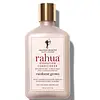What's inside
What's inside
 Key Ingredients
Key Ingredients

 Benefits
Benefits

 Concerns
Concerns

 Ingredients Side-by-side
Ingredients Side-by-side

Mangifera Indica Fruit Extract
Skin ConditioningPassiflora Incarnata Fruit Extract
Skin ConditioningCamellia Sinensis Leaf Extract
AntimicrobialSodium Cocoyl Isethionate
CleansingCoco-Betaine
CleansingSodium Methyl Cocoyl Taurate
CleansingSodium Cocoyl Glutamate
CleansingDisodium Cocoyl Glutamate
CleansingSodium Chloride
MaskingGlycerin
HumectantOenocarpus Bataua Seed Oil
EmollientPlukenetia Volubilis Seed Oil
EmollientSucrose
HumectantCocoyl Hydrolyzed Quinoa Protein
Mauritia Flexuosa Fruit Oil
Skin ConditioningKaolin
AbrasiveAroma
Cymbopogon Nardus Oil
MaskingLactic Acid
BufferingHydroxyethylcellulose
Emulsion StabilisingGlycine
BufferingCoco-Caprylate
EmollientXanthan Gum
EmulsifyingArginine
MaskingPotassium Sorbate
PreservativeGuar Hydroxypropyltrimonium Chloride
Skin ConditioningMangifera Indica Fruit Extract, Passiflora Incarnata Fruit Extract, Camellia Sinensis Leaf Extract, Sodium Cocoyl Isethionate, Coco-Betaine, Sodium Methyl Cocoyl Taurate, Sodium Cocoyl Glutamate, Disodium Cocoyl Glutamate, Sodium Chloride, Glycerin, Oenocarpus Bataua Seed Oil, Plukenetia Volubilis Seed Oil, Sucrose, Cocoyl Hydrolyzed Quinoa Protein, Mauritia Flexuosa Fruit Oil, Kaolin, Aroma, Cymbopogon Nardus Oil, Lactic Acid, Hydroxyethylcellulose, Glycine, Coco-Caprylate, Xanthan Gum, Arginine, Potassium Sorbate, Guar Hydroxypropyltrimonium Chloride
Water
Skin ConditioningCetearyl Alcohol
EmollientDimethicone
EmollientStearamidopropyl Dimethylamine
EmulsifyingHydrolyzed Elastin
EmollientHydrolyzed Keratin
HumectantHydrolyzed Wheat Protein
Skin ConditioningCaulerpa Lentillifera Extract
Behentrimonium Chloride
PreservativeParfum
MaskingDipropylene Glycol
HumectantLactic Acid
BufferingAmodimethicone
Trehalose
HumectantGluconolactone
Skin ConditioningCocos Nucifera Oil
MaskingPotassium Chloride
Disodium EDTA
PEG-7 Propylheptyl Ether
Emulsion StabilisingCetrimonium Chloride
AntimicrobialSodium Sulfate
Methylchloroisothiazolinone
PreservativeMethylisothiazolinone
PreservativeWater, Cetearyl Alcohol, Dimethicone, Stearamidopropyl Dimethylamine, Hydrolyzed Elastin, Hydrolyzed Keratin, Hydrolyzed Wheat Protein, Caulerpa Lentillifera Extract, Behentrimonium Chloride, Parfum, Dipropylene Glycol, Lactic Acid, Amodimethicone, Trehalose, Gluconolactone, Cocos Nucifera Oil, Potassium Chloride, Disodium EDTA, PEG-7 Propylheptyl Ether, Cetrimonium Chloride, Sodium Sulfate, Methylchloroisothiazolinone, Methylisothiazolinone
Alternatives
Ingredients Explained
These ingredients are found in both products.
Ingredients higher up in an ingredient list are typically present in a larger amount.
Lactic Acid is another well-loved alpha hydroxy acid (AHA). It is gentler than glycolic acid but still highly effective.
Its main role is to exfoliate the surface of the skin by loosening the “glue” that holds dead skin cells together. Shedding those old cells leads to smoother, softer, and more even-toned skin.
Because lactic acid molecules are larger than glycolic acid, they don’t penetrate as deeply. This means they’re less likely to sting or irritate, making it a great choice for beginners or those with sensitive skin.
Like glycolic acid, it can:
Lactic acid also acts as a humectant (like hyaluronic acid). It can draw water into the skin to improve hydration and also plays a role in the skin's natural moisturizing factor (NMF) in the form of sodium lactate.
Studies show it can boost ceramide production to strengthen the skin barrier and even help balance the skin’s microbiome.
To get results, choose products with a pH between 3-4.
Lower strengths (5-12%) focus on surface exfoliation; higher strengths (12% and up) can reach deeper in the dermis (deeper, supportive layer) to improve skin texture and firmness over time.
Though it was originally derived from milk, most modern lactic acid used in skincare is vegan. It is made through non-dairy fermentation to create a bio-identical and stable form suitable for all formulations.
When lactic acid shows up near the end of an ingredient list, it usually means the brand added just a tiny amount to adjust the product’s pH.
Legend has it that Cleopatra used to bathe in sour milk to help reduce wrinkles.
Lactic acid is truly a gentle multitasker: it exfoliates, hydrates, strengthens, and brightens. It's a great ingredient for giving your skin a smooth, glowing, and healthy look without the harshness of stronger acids.
Read more about some other popular AHA's here:
Learn more about Lactic Acid